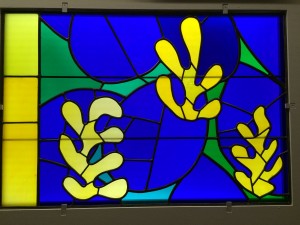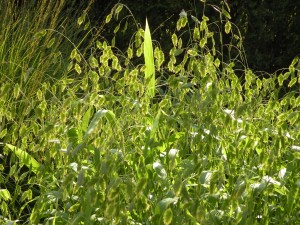We’ve been spoiled recently with sun and warm temperatures but as wintery gray days approach, we will yearn for light.
There are different aspects of light that we don’t always recognize. When we see a plant that is backlit, we see elements that went unrecognized. For instance, each tiny, bristly hair on the brush-like inflorescence of Pennisetum (Fountain Grass) is illuminated when backlit. The leaves of Imperata cylindrica ‘Red Baron’ (Blood Grass) are usually ruby bed but when backlit, they are fiery red. The jagged edges of the oat-like inflorescence of Chasmanthium latifolium (Northern Sea Oats) become chartreuse when lit from behind. The most impressive example of backlighting I have ever seen was in a public park in Spokane in late October of 2009 when it had snowed the previous night. There were several Acer griseum (Paperbark Maple) and pieces of the rust-colored, exfoliating bark were bright yellow and orange. It was almost as though flames were dancing through the branches.

Early morning sun on Miscanthus ‘Adagio’
We rarely think of frontlighting but it can add another element to our landscapes that will cheer us. Most of the ornamental grasses are beige during the winter but when hit by early morning light, they become golden yellow.

Brass armillary
Have you ever noticed how light bounces off of metal objects? What if you had a brass armillary on a pedestal in part of your landscape that you can see from one of your windows? Wouldn’t it be lovely to look outside during the winter and see it gleaming whenever rays of light strike it?

Colorful glass sculpture set in woodland

Patterned metal and glass panels
Glass objects can be used in a few different ways to brighten gray days. One is using it as a reflector – perhaps an unusual glass sculpture like one I saw in a woodland garden in Cincinnati. When the deciduous trees behind it have dropped all their leaves, it will become even more of a focal point. Or using it as space divider like some panels I saw in Amsterdam. Just think how gorgeous those panels would be if the glass were a color that would change shades during the day with the light.

Blue glass wall
Colored glass would be beautiful on its own but when backlit or frontlit would be even be more spectacular. Most glass block walls are utilitarian but when colored, like one I saw in Germany, they can be a lovely addition to the landscape, even more so during the winter.

Matisse design for windows at Chapelle du Rosaire (Couvent des Dominicaines) in Vence
Another type of glass – stained glass is absolutely gorgeous when backlit. Although we usually see it only in churches, there is no reason not to put it our gardens, being conscious when placing it of situating it so that it will be backlit either in the morning or late afternoon.
I’m running out of space in my garden for more art but in writing this post, I want to find a place for colored glass. Where, oh where, is that place?






0 Comments